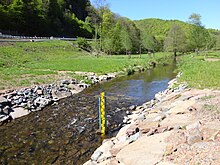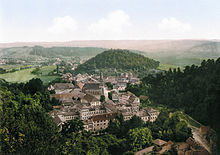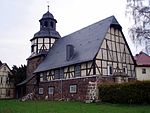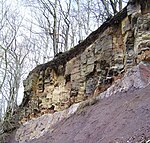Ilfeld
|
Ilfeld
Harztor rural community
|
||
|---|---|---|
| Coordinates: 51 ° 34 ′ 37 ″ N , 10 ° 47 ′ 13 ″ E | ||
| Height : | 253 m | |
| Area : | 62.33 km² | |
| Residents : | 2954 (Dec. 31, 2010) | |
| Population density : | 47 inhabitants / km² | |
| Incorporation : | January 1, 2012 | |
| Postal code : | 99768 | |
| Area code : | 036331 | |
|
Location of Ilfeld in Thuringia |
||
|
View of Ilfeld from the Ilfeld weather vane , with Niedersachswerfen in the background
|
||

Ilfeld is a district of the Harztor rural community in the Nordhausen district ( Thuringia ) in the southern Harz .
geography
location
Ilfeld is located nine kilometers (as the crow flies) north of the district town of Nordhausen . Geographically, Ilfeld marks the southern border of the Harz .
Mountains and waters
The Poppenberg (height 601 m above sea level ) towers over the place in the east. Ilfeld lies in the valley of the Bere , a tributary of the Zorge . The section above the forest pool is considered to be scenic and is known as the Kleines Bodetal . The actual Ilfeld valley of the Bere is a nature reserve with numerous rock formations and forest areas, it extends as far as Netzkater .
Districts
The districts of Wiegersdorf , Sophienhof and Netzkater belonged to the former community of Ilfeld .
history
Around 1100 the Counts of Bielstein built the Ilburg on today's castle hill in Ilfeld . From then on, this branch of the family was called Ilburger . The two-part castle complex with a ring wall and moat was used to monitor the old north-south road that connected Nordhausen and the Goldene Aue and Bad Harzburg and Goslar across the Harz. In 1154 the Lords of Ilfeld and 1157 a Edelger von Ilfeld were named for the first time. The remains of the keep and walls can still be seen.
The once great, 1189, with the support of the monastery Pöhlde founded Norbertine - Monastery Ilfeld to the legend, at the instigation of Count Ilburger Elger II and his wife Lutrude, after his happy return from a pilgrimage to. Jerusalem have originated. Until the Reformation, the Ilfeld Monastery was the capital of one of the seven circariums (provinces) of the Premonstratensian Order in Germany.
The Ilfeld area has belonged to the Duchy of Braunschweig since the High Middle Ages - as a result of the War of the Hessian-Thuringian Succession - after the Ilburg Counts died out, it became part of the County of Hohnstein . In the 16th century, Protestantism spread around the former imperial city of Nordhausen , and the Ilfeld monastery was subsequently dissolved by Thomas Stange, the last abbot , in 1546. He also decreed that the monastery buildings should continue to be used as a school; from this the later Royal Pedagogy Ilfeld developed . The extensive lands of the monastery remained as Stift Ilfeld from 1632 with the Duchy of Braunschweig-Lüneburg , in 1737 it served as a special fund in the administration of the monastery chamber for the foundation of the University of Göttingen .
The economic basis of the Ilfeld was mining (copper and hard coal). The manganese mineral known as brown stone - at the Braunstein-Haus forest village - was also used. Johann Wolfgang von Goethe stayed in Ilfeld in 1777 in the Gasthaus Zur Krone .
The name Grafschaft Hohenstein referred to the Prussian county in the 19th century (originated from the Honstein-Lohra-Klettenberg line); next to it there was the former family county honing stone to Ilfeld and New Town, which was partly become welfisch from the possession of the Earls of Stolberg 1803 and 1815 in the Kingdom of Hanover under the name Province Hohnstein , then in the Landdrostei Hildesheim County Hohnstein and finally office Hohnstein was led . After Prussia had incorporated Hanover as a province in 1866, an administrative reform came into force in 1885, in which the Hohnstein office was combined with the Elbingerode office to form the Ilfeld district (both offices were separated from each other by Brunswick territory). On 1 October 1932, the county was divided Ilfeld: The old office Hohnstein was the county county Hohenstein in the administrative district of Erfurt of the Prussian province of Saxony affiliated with the old office Elbingerode among Wernigerode in the Region of Magdeburg (also province of Saxony).
After the Harzquerbahn reached Ilfeld in 1898, tourism slowly started . Between 1866 and 1932 Ilfeld was the capital of the Prussian district of Ilfeld .
In the time of National Socialism , the monastery school served as a national political educational institution . During the Second World War , 125 prisoners of war from the Soviet Union as well as women and men from various countries occupied by Germany had to do forced labor : in the monastery , in the forest administration , in the southern Harz barrel factory , in the railway maintenance department I , in the Otto Günther paper factory , in the Junkers-Nordwerk and in the convent school . In January 1945 prisoners set up a subcamp Ilfeld of the Mittelbau-Dora concentration camp with 260 prisoners. In the Franz Krieger quarry , prisoners also had to work under inhumane conditions. In April 1945, the camp was evacuated and the prisoners were driven by SS members , carrying out massacres, on death marches on foot and evacuation transports by train. Most of the survivors of this eviction were murdered in Gardelegen during the massacre in the Isenschnibber field barn on April 13, 1945.
The district town of Nordhausen, which was still badly destroyed at the end of the war, evacuated numerous bombed-out residents to the surrounding communities. The Nordhausen Hospital was also relocated, and it was temporarily admitted to Ilfeld. A year later, the former monastery village of Wiegersdorf was incorporated.
During the GDR era, Ilfeld was expanded to become a tourist destination for the FDGB . Every year over 10,000 guests visited the site and were accommodated in company homes and holiday camps. The wooded area was used for spa operations, and a spa park was created in the local area .
The merger of Ilfeld and Lower Saxony to form a rural community called Harztor was decided on December 16, 2011 by the Thuringian state parliament on January 1, 2012.
Culture and sights
Memorials
- A stele in the spa gardens and another in the village of Netzkater behind the B4 / B81 junction have been commemorating the victims of a death march by inmates of Mittelbau-Dora concentration camp since 1984, who were driven through the village in the spring of 1945.
- The grave of the German soldiers who died on April 13, 1945 in the Ilfeld Valley can be found in the old cemetery of Ilfeld
Architectural monuments
- A local history museum is housed in the old town hall, built in 1712 at Ilburgstrasse 51.
- The historical location surrounds the castle hill with the ruins of the Ilburg .
- The St. Georg-Marien church is a Protestant church.
- In the Wiegersdorf district, the St. Jacobi fortified church , which is also Protestant, can be visited.
- The Neanderklinik Harzwald GmbH is located in the buildings of the former monastery , later the monastery school
- The observation tower built in 1894 with steel lattice technology on the 600 meter high Poppenberg (“Little Eiffel Tower ”, highest landmark of the city) was restored after the Second World War and allows a wide view over the nature reserve South Harz.
Natural monuments
The long wall is located at the southern entrance to the village on the steep bank of the Bere . The geological information on an information board illustrates the history of the development of the Harz Mountains and the Harz foreland. The former copper mine is almost in its original condition. This mine and the Rabensteiner tunnel in Ilfeld, Netzkater 8, a 300-year-old coal mining tunnel , can be visited on guided tours. Well-known natural monuments and hiking destinations in the immediate vicinity of Ilfeld are the goose beak , the eye of the needle and the monk .
Recreational facilities
The Waldbad Ilfeld is about a 20-minute walk from the village in the Ilfeld Valley . The Südharz sports facility and the Weidentalswiese sports field were built as sports facilities as early as the GDR era.
Population development
Development of the population:
|
|
|
- Data source: from 1994 Thuringian State Office for Statistics - values from December 31st
politics
Municipal council
Since the local elections on June 7, 2009, the last municipal council has been composed as follows:
mayor
In the last mayoral election in 2004, Rene Schröter-Appenrodt received 64.0% of the votes from the CDU, his opponent Gisela Gärtner from the SPD 36.0%.
coat of arms
In 1905, the King of Prussia granted the community of Ilfeld the right to use the coat of arms described below.
- Description of coat of arms
- “Split and half divided; in front a green rooted tree in gold, marked with a red 'O', in the back above in red on green ground a silver monastery, in the back below in silver-red pits . "
Economy and Infrastructure
tourism
Ilfeld bears the title of a state-recognized resort. There are several hotels, pensions and holiday homes in the village. Annually Ilfeld is visited by around 10,000 vacationers with around 30,000 overnight stays.
traffic
Bundesstrasse 4 and the Harzquerbahn run directly through Ilfeld . The latter is part of the Harzer Schmalspurbahnen (HSB) network, with tram line 10 running to Ilfeld since 2004 . With this there is a direct connection to downtown Nordhausen every hour on weekdays, made possible by the use of hybrid vehicles . A daily steam train runs continuously up to the Brocken .
Public facilities
- From 1990 to 1992 the Ilfeld Mountain Protection Department of the Thuringian Ministry of Environment and Geology was located in Ilfeld . The company, which has been independent since January 2001, emerged from a special company founded in 1974 for the exploration, security and custody of old mining facilities.
- The Neander Clinic , which emerged from parts of the Nordhäuser Hospital, is a health center for rehabilitation and care for the elderly.
schools
Ilfeld has a primary school and a grammar school, which forms the Michael Neander school part of the Johann Gottfried Herder grammar school in Nordhausen.
Personalities
Sons and daughters
- Erasmus Rothmaler the Elder (1562–1611), Lutheran clergyman
- Just Christian Stuß (1725–1788), classical philologist, writer and clergyman
- Friedrich Meisner (1765–1825), natural scientist and university professor in Bern
- Friedrich August Grotefend (1798–1836), philologist
- Carl Capelle (1841–1912), classical philologist
- Wilhelm Deppe (1843–1904), President of the State Parliament and Member of the Reichstag
- Paul Abert (1879–1947), theologian and writer
- Willy Brandt (1885–1975), philologist and educator
- Manfred Bornemann (1933–2012), geologist and non-fiction author
Personalities associated with Ilfeld
- Heinrich Ludolf Ahrens (1809–1881), teacher at the monastery school
- Georg Basilius Brinkmann (1662–1735), pastor in Ilfeld
- Johann Ludwig Meil (1729–1772), teacher at the monastery school
- Michael Neander (1525–1595), Lutheran and important rector of the Ilfeld monastery school
- Michael Richter (* 1952), contemporary historian and aphorist, attended school here
- Marcus Ites (1883–1962), director of the monastery school
- Friedrich August Wolf (1759–1824), teacher at the monastery school
- August Ernst Zinserling , teacher at the monastery school
literature
- Manfred Bornemann: Ilfeld. A chronicle. Self-published, Hamburg 1999, ISBN 3-929767-38-4 .
- Ludwig Lüder: Ilfeld. A look into the history of the spot. Neukirchner, Nordhausen 2002, ISBN 3-929767-55-4 .
- Ernst Wiedasch: The list of all the pupils of the Ilfeld Pedagogy since it was founded. Pedagogy (school program), Ilfeld 1853 ( digitized version )
Web links
- Website Heimatmuseum Ilfeld (with a link to the Ilfeld Chronicle)
- Pictures of the life and death of old Ilfeld citizens
Individual evidence
- ↑ a b (Colored black and white photo)
- ↑ Manfred Bornemann: The Counts of Ilfeld . In: Meyenburg Museum (ed.): Contributions to local history from the city and district of Nordhausen . Issue 25. Nordhausen 2000, p. 3-13 .
- ↑ Michael Köhler: Thuringian castles and fortified prehistoric and prehistoric living spaces Jenzig - Verlag 2001, ISBN 3-910141-43-9 , p. 146.
- ↑ Castle
- ↑ Horst Graevert: The Ilfeld brown stone houses . In: Meyenburg Museum (ed.): Contributions to local history from the city and district of Nordhausen . Issue 10. Nordhausen 1985, p. 10-18 .
- ↑ Thuringian Association of the Persecuted of the Nazi Regime - Association of Antifascists and Study Group of German Resistance 1933–1945 (Ed.): Heimatgeschichtlicher Wegweiser to places of resistance and persecution 1933–1945, series: Heimatgeschichtliche Wegweiser Volume 8 Thüringen, Erfurt 2003, ISBN 3- 88864-343-0 .
- ↑ StBA: Area changes from January 1st to December 31st, 2012
- ↑ Horst Graevert: copper mining between Ilfeld and Stempeda . In: Meyenburg Museum (ed.): Contributions to local history from the city and district of Nordhausen . Issue 19. Nordhausen 1994, p. 115 ff .
- ↑ Horst Graevert: coal industry Ilfeld and Neustadt . In: Meyenburg Museum (ed.): Contributions to local history from the city and district of Nordhausen . Issue 12. Nordhausen 1987, p. 60-63 .
- ^ Johannes Erhardt: Nordhausen am Harz, Ilfeld - Neustadt . In: Our little hiking booklet . tape 101 . Brockhaus Verlag, Leipzig 1966, p. 64 .
- ↑ Horst Graevert: The Bergsicherung Ilfeld . In: Meyenburg Museum (ed.): Contributions to local history from the city and district of Nordhausen . Issue 5. Nordhausen 1980, p. 72-77 .








